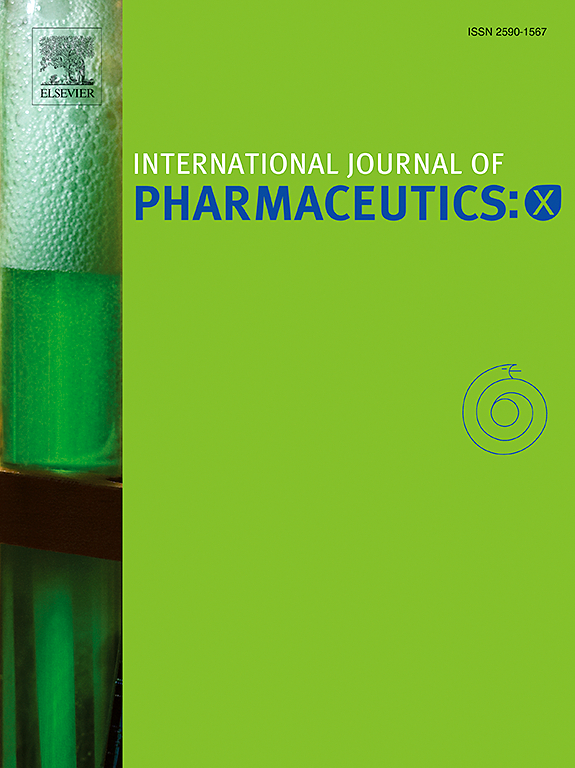Development of an inhalable dry powder formulation for inhibition of SARS-CoV-2
IF 6.4
2区 医学
Q1 PHARMACOLOGY & PHARMACY
引用次数: 0
Abstract
Coronaviruses, including SARS-CoV-2, can cause significant lung damage and may result in multiple organ failure. The severity of COVID-19 is determined by the virus's entry into lung tissue and subsequent replication. This entry is facilitated by the angiotensin-converting enzyme 2 (ACE2) in combination with the serine protease TMPRSS2, which is a critical step. To reduce viral replication, it is necessary to prevent the uptake of the virus directly at the main route of transmission, which is the deposition of the virus as an aerosol in the respiratory tract. To reduce viral uptake into lung cells, an inhalable dry powder formulation was developed. The formulation contains camostat, a clinically proven serine protease inhibitor that inhibits the cellular uptake mechanisms on the lung surface. Camostat was spray-dried together with the mucolytic agent N-acetylcysteine to produce co-amorphous microparticles with sufficient solubility after deposition. Microparticles with properties suited for deposition in the deep part of the respiratory tract can be produced by using appropriate spray-drying parameters. The use of L-leucine enabled suitable aerodynamic properties and storage stability due to reduced interaction with environmental water. The geometric particle diameter, determined using laser light diffraction, decreased with L-leucine content which was found forming a partially crystalline L-leucine shell. The disintegration behavior of the microparticle formulation simulated under lung-like conditions indicated fast disintegration. A pseudo-viral in vitro assay demonstrated low acute toxicity in combination with a high activity. Cell viability and proliferation were not affected by camostat concentrations up to 11.1 μg/mL. The IC50 values of the two dry powder formulations tested on a HEK293T/ACE2-TMPRSS2 cell line were 0.008 μg/mL and 0.019 μg/mL, respectively, which is at least 100 times lower than the cytotoxic concentration. This dry powder formulation serves as a prototype microparticle matrix for incorporating nanoscale drug carriers in the future.

抑制SARS-CoV-2的可吸入干粉制剂的研制
包括SARS-CoV-2在内的冠状病毒可造成严重的肺损伤,并可能导致多器官衰竭。COVID-19的严重程度取决于病毒进入肺组织并随后进行复制。血管紧张素转换酶2 (ACE2)与丝氨酸蛋白酶TMPRSS2共同促进了这一进入,这是一个关键步骤。为了减少病毒复制,有必要防止在主要传播途径上直接摄取病毒,即病毒在呼吸道中以气溶胶形式沉积。为了减少病毒进入肺细胞的摄取,开发了一种可吸入的干粉制剂。该制剂含有卡莫司他,一种临床证实的丝氨酸蛋白酶抑制剂,可抑制肺表面的细胞摄取机制。卡莫司他与粘解剂n -乙酰半胱氨酸一起喷雾干燥,沉积后产生具有足够溶解度的共无定形微颗粒。通过使用适当的喷雾干燥参数,可以生产出适合在呼吸道深部沉积的微粒。l -亮氨酸的使用减少了与环境水的相互作用,使其具有合适的空气动力学特性和储存稳定性。激光衍射测定的几何颗粒直径随着l -亮氨酸含量的增加而减小,形成了部分结晶的l -亮氨酸壳。模拟微颗粒制剂在肺样条件下的崩解行为表明崩解速度快。伪病毒体外试验显示低急性毒性与高活性的组合。卡莫司他浓度达到11.1 μg/mL时,对细胞活力和增殖无影响。两种干粉制剂在HEK293T/ACE2-TMPRSS2细胞株上的IC50值分别为0.008 μg/mL和0.019 μg/mL,均比细胞毒浓度低至少100倍。这种干粉制剂可作为未来纳米级药物载体的原型微粒基质。
本文章由计算机程序翻译,如有差异,请以英文原文为准。
求助全文
约1分钟内获得全文
求助全文
来源期刊

International Journal of Pharmaceutics: X
Pharmacology, Toxicology and Pharmaceutics-Pharmaceutical Science
CiteScore
6.60
自引率
0.00%
发文量
32
审稿时长
24 days
期刊介绍:
International Journal of Pharmaceutics: X offers authors with high-quality research who want to publish in a gold open access journal the opportunity to make their work immediately, permanently, and freely accessible.
International Journal of Pharmaceutics: X authors will pay an article publishing charge (APC), have a choice of license options, and retain copyright. Please check the APC here. The journal is indexed in SCOPUS, PUBMED, PMC and DOAJ.
The International Journal of Pharmaceutics is the second most cited journal in the "Pharmacy & Pharmacology" category out of 358 journals, being the true home for pharmaceutical scientists concerned with the physical, chemical and biological properties of devices and delivery systems for drugs, vaccines and biologicals, including their design, manufacture and evaluation. This includes evaluation of the properties of drugs, excipients such as surfactants and polymers and novel materials. The journal has special sections on pharmaceutical nanotechnology and personalized medicines, and publishes research papers, reviews, commentaries and letters to the editor as well as special issues.
 求助内容:
求助内容: 应助结果提醒方式:
应助结果提醒方式:


